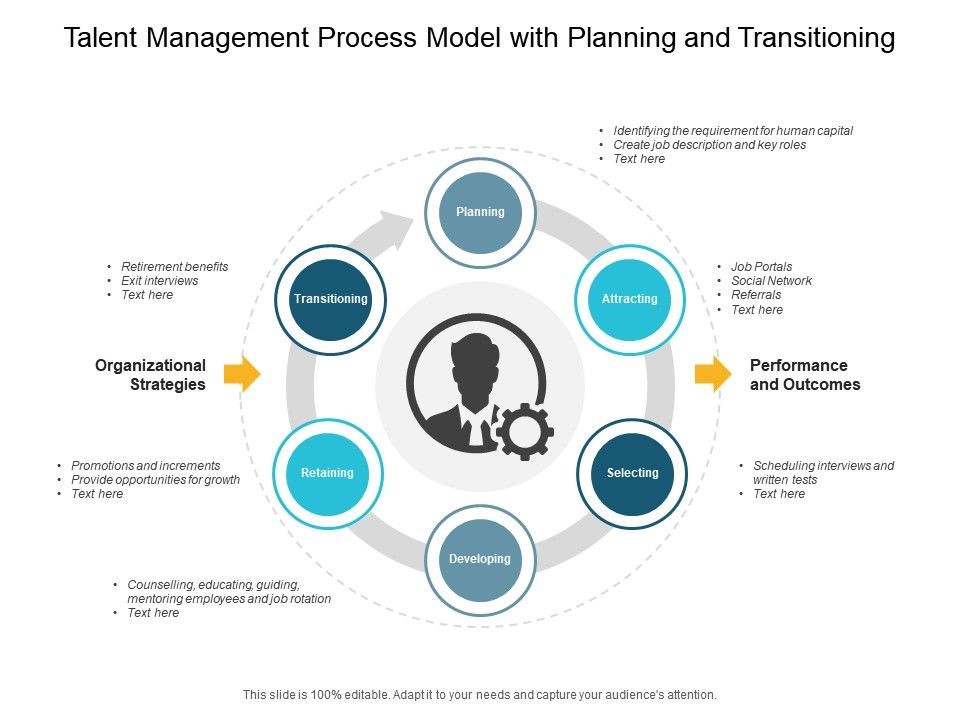Talent Management in VUCA World
Talent Management Process
Talent management is defined as the methodically organized, strategic process of getting the right talent onboard and helping them grow to their optimal capabilities keeping organizational objectives in mind.1
Steps of the talent management process include planning, attracting, selecting, developing, retaining and transitioning.

In order for managers to respond quickly to the disruptive events mentioned above and to similar events that may occur, talent management could be focused on five main sectors talent: acquisition, leadership development, process, innovation, and analytics.2, 3
1. Talent Acquisition
- Recruiters need to learn how to identify and select new hires that are very much adaptive and can learn quickly to match the highly changing environment
- Companies can also increase the percentage of their contingent workforce
- Companies should try and develop fluid job descriptions that describe the different skills and tasks needed to be achieved by each employee
- Recruiters may also consider outsourcing as a flexible alternative to fill sudden needs and overflow of work
- Recruiters need to hire tech savvy employees equipped and updated with the skills needed for the rapid technological changes taking place
2. Leadership Development
The role of leaders has changed dramatically with the introduction of new leadership models including “Agility”.
- The changing business environment needs leaders who are equipped with “adaptive” skill sets
- Managers need to learn how to act as facilitators to give space for employees to proactively suggest solutions for the frequent disturbing events
- Management needs to be more decentralized and more teams and sub team leaders need to be developed in order to make it easier to develop effective and adaptive teams
- VUCA leaders need to be fast decision-makers, innovators, and able to learn quickly. Moreover, they need to be able to deliver their skills among their team members
- Leaders in today’s business world need to have the skills needed for the use of virtual learning options, including social media and wikis
3. Process
The process of talent management itself can become a company’s competitive advantage when companies are able to deliver fast and effective solutions over other talent competitors.
- Processes need to be agile, flexible and responsive to change
- Talent Management processes need to “self-obsolete”, meaning that the process includes a component that can automatically update old practices with new ones
- Systems need to include a process for “rapid learning” to increase the speed of individual and organizational learning
- Talent management processes should include a process for proactively speeding up the internal movement of employees to areas where they have a greater impact
4. Innovation
- When hiring employees a focus has to be given to innovators, game changers, and pioneers who are essential for the success in today’s business world
- Talent management needs to develop an appropriate work environment that enables collaboration and cross team interaction
- In order for innovation to be a continuous goal for the organization, the entire organization must work in unison, experimentation and risk taking will have to be encouraged in every aspect of the organization
- New models of learning including virtual learning needs to be encouraged to increase the development of team members
- Talent management leadership needs to successfully measure, recognize and reward collaboration, risk-taking, and successful innovation
5. Analytics
- Assessment centers and accurate online tools need to be developed to allow the development of data-based, more- scientific and metric driven results to allow leaders to make quick and accurate decision, “the first time”
- Predictive analytics like that of weather prediction are needed to speed up decision making and reduce the planning stage. Within talent management, Google has successfully produced predictive analytics in hiring, leadership, and retention. Another example includes Sprint which used analytics to predict which new hires were likely to quit. Cisco once used predictive measures to identify which struggling new hires were likely to succeed over the long term4
In conclusion, talent management processes need to avoid falling into the traditional trap of “one –size fits all when developing their process or when managing employees. Moreover, talent management should stop benchmarking past solutions to current problems. Corporate values and objectives need to be updated frequently on a periodic basis to ensure they are aligned with the changes happening in the VUCA world.
1https://www.hrtechnologist.com/articles/performance-management-hcm/what-is-talent-management/#02
2https://drjohnsullivan.com/uncategorized/how-the-talent-management-function-can-thrive-in-a-vuca-world/
3https://www.ere.net/vuca-the-new-normal-for-talent-management-and-workforce-planning/
4https://drjohnsullivan.com/uncategorized/how-the-talent-management-function-can-thrive-in-a-vuca-world/
For more about this topic, download our latest book "Reality of the World Today" for FREE:
